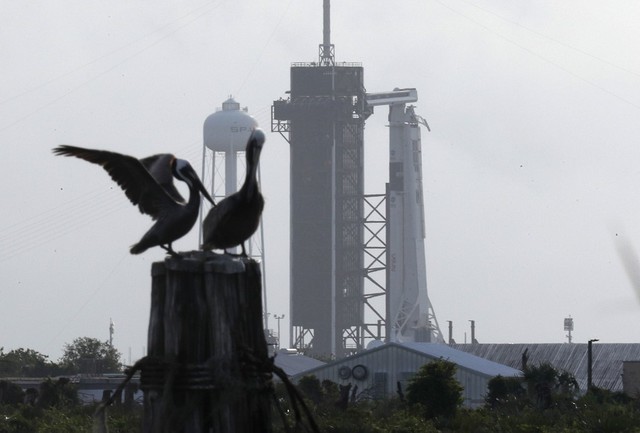SpaceX readies for blast-off with NASA astronauts aboard
NASA is finally ready to go – or as ready as they can be to strap two people on top of a 500-ton rocket filled with combustible fuel
by Agence France-Presse
CAPE CANAVERAL, USA – Gray skies loomed over Florida's Atlantic coast Tuesday, May 26, just one day before two astronauts were set to blast off aboard a SpaceX capsule on the most dangerous and prestigious mission NASA has ever entrusted to a private company.
There was a 60% chance for favorable weather for Wednesday's flight, according to Tuesday's latest Cape Canaveral forecast.
US astronauts Bob Behnken and Doug Hurley have been in strict quarantine for two weeks ahead of their trip on the brand-new Crew Dragon capsule, which will be propelled by a Falcon 9 rocket.
Both the capsule and the rocket were manufactured by SpaceX, the start-up founded in 2002 by the then-thirty-something Elon Musk, a brilliant and brash Mars-obsessive who made his fortune with PayPal and also created the famous Tesla electric cars.
The Crew Dragon is to carry the astronauts to the International Space Station (ISS), which orbits the Earth about 250 miles (400 kilometers) above sea-level at about 17,000 miles per hour.
The success of this mission is a point of national pride for the United States, which has depended on Russian rockets to reach space since its last crewed flight in 2011.
Neither the new coronavirus pandemic nor confinement measures to stop its spread were able to derail the launch, and President Donald Trump will become only the third US leader to watch the take-off of a human space flight in person, after Richard Nixon and Bill Clinton.
"This is a unique moment where all of America can take a moment and look at our country do something stunning again," NASA administrator Jim Bridenstine said.
In a nod to an earlier era of US space flight, Bridenstine resurrected a vintage 1970s NASA logo nicknamed "the worm," whose distinctive red font will adorn the rocket on Wednesday.
SpaceX made history in 2012 when it became the first private entity to dock a cargo capsule to the ISS. Two years later, NASA commissioned the company to modify the Dragon to carry passengers.
That was already Musk's original dream for the capsule anyway, according to SpaceX vice president Hans Koenigsmann.
"Cargo Dragon, we put a window on it so that people wouldn't forget about it," he said of the original ship design.
"We (were) founded with the idea of human spaceflight."
Delays
The program, into which NASA has invested more than $3 billion, is 3 years behind schedule.
And a NASA-commissioned Boeing spacecraftcalled the Starliner, is even further delayed.
After a successful uncrewed test flight last year, a Crew Dragon capsule later exploded during a ground engine test. There were also issues developing the capsule's large parachutes.
But after thousands of checks and re-checks, NASA is finally ready to go – or as ready as they can be to strap two people on top of a 500-ton rocket filled with combustible fuel.
"We never feel comfortable, because that's when you're not searching," said Kathy Lueders, head of NASA's commercial crew program.
"We're going to stay hungry until Bob and Doug come home," she said.
'Above geopolitics'
Now, the weather is the last unpredictable variable.
But "the trend is in the right direction," Bridenstine said, despite the rain that forced his Tuesday press conference indoors and away from the big countdown clock outside.
The option to delay remains available until 45 minutes before the flight's scheduled departure at 4:33 pm (2033 GMT).
The next potential windows for blast-off are Saturday and Sunday.
After they reach orbit, it will take Hurley and Behnken around 19 hours to reach the ISS, where Bridenstine says they could stay until early August.
Their return will resemble the Apollo re-entries: a water landing in the Atlantic Ocean, off the coast of Florida.
If all goes well, the Crew Dragon could then begin regular flights from the United States to the ISS.
At the end of August, 3 other Americans and a Japanese astronaut are scheduled to fly on the ship, and Europe, Canada, and Russia have been invited to participate in subsequent missions.
The Russians, with whom the US built the ISS, have agreed to continue their space partnership, according to Bridenstine, though they have not officially signed onto the new program.
"It's really above terrestrial geopolitics," he said. "Literally – above terrestrial geopolitics." – Rappler.com